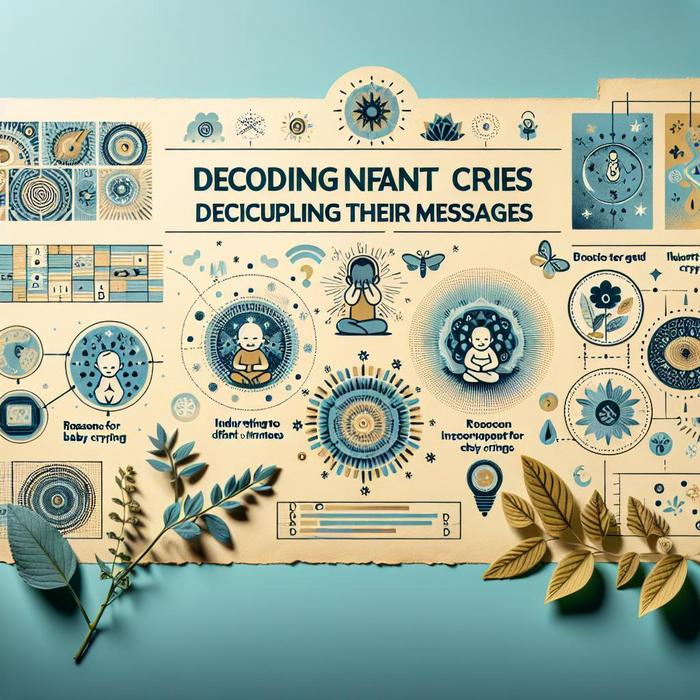Understanding Baby Cries: Interpreting the Voiceless Language
It’s natural for new parents to feel a wave of confusion when their baby cries. You might wonder if your baby is hungry, needs a diaper change, or is feeling unwell. You’re not alone in this – understanding baby cries can indeed be a daunting task. However, your baby’s cries are their primary means of communication and learning to interpret them can strengthen your emotional connection with your little one.
Why Do Babies Cry?
Babies cry as a form of communication. It’s their way of expressing a wide variety of needs and discomforts. It could be simple hunger, a wet diaper, or tiredness. They may also cry when they are overwhelmed by bright lights, loud noises, or perhaps when they just need a loving cuddle. Understanding these cues can take some time and patience, but rest assured, it comes naturally over time.
Deciphering Different Types of Cries
It might seem like all baby cries are the same, but if you listen closely, you’ll start to notice subtle differences. Here are some common types of cries and what they usually denote:
- Hunger Cry: A rhythmic and repetitive cry, often accompanied by sucking fingers or making smacking sounds. This usually means your baby is ready for a feed.
- Tired Cry: A cry that starts and stops, often accompanied by rubbing eyes or yawning. This indicates that it’s time for a nap.
- Discomfort Cry: An irritated cry that can escalate quickly. This could mean that your baby needs a fresh diaper or is uncomfortable in their clothing.
- Pain Cry: A high-pitched, urgent cry that comes suddenly. This suggests your baby might be in pain.
- Overstimulation Cry: A fussy, whiny cry that happens when there’s too much happening around your baby. It’s their way of saying ‘it’s all too much’.
Resources to Help You Understand Your Baby’s Cries
If you’re struggling to understand your baby’s cries, know that there are resources available to help, such as Raising Children. This website provides a comprehensive guide to understanding newborn behavior, which can provide clarity during confusing times.
Additional Tips for Understanding Baby Communication
Understanding baby cries is just one part of communicating with your newborn. Consider these additional tips to further improve your communication with your baby:
- Monitor Their Body Language: Babies often communicate through body movements. Understanding these body cues can provide more insights into what your baby might be trying to tell you.
- Listen to the Pitch of the Cry: High-pitched cries often indicate discomfort or pain, whereas low-pitched cries may suggest tiredness or hunger.
- Be Patient: Learning to understand your baby’s cries can take time. Be patient with yourself and know that it’s a learning process.
If you’re interested in exploring more about parenting and baby behaviors, the Feed Guide offers a plethora of resources on various topics, including common parental fears in the first year and how to overcome them.
Understanding Baby Cries: The Journey of Parenting
Decoding baby cries might seem intimidating at first, but it’s an integral part of the beautiful journey of parenthood. Remember, no one understands your baby better than you do. With time, patience, and love, you’ll begin to understand their unique language.
Understanding Baby Cries with Technology
The evolution of technology has provided us with applications or software to help understand baby cries. One such technology is the ChatterBaby application developed by the University of California, Los Angeles (UCLA). They have successfully used artificial intelligence to navigate the realm of infant cries and assist parents in better managing the situation. This technology has shown promising results and can be particularly useful for first-time parents who are unfamiliar with baby communication patterns.
Check out this article here to get in-depth knowledge about how artificial intelligence is being used to decode infant cries.
BabyCenter on Decoding Baby Cries
BabyCenter provides useful advice on how parents can identify the different reasons why babies cry, helping parents decipher the specific needs of their infants accurately. Reading this information can help you develop a better understanding and instinct when it comes to your baby’s cries.
Applying the Dunstan Baby Language Method
You might also consider using the Dunstan Baby Language method. This method, developed by Priscilla Dunstan, uses audio cues to interpret baby cries. The method categorizes crying into five different sounds, each indicating specific babies’ needs. Turning to such structured methods might offer insights and make the process of understanding baby cries easier for parents.
How to Soothe a Crying Baby
Understanding baby cries is one thing, but knowing how to soothe a crying baby is equally important. The Developmental Science blog gives recommendations on how to soothe a crying baby based on extensive research and evaluation.
For more tips, visit their blog post here.
Stay Engaged and Involved
While these resources may provide a fundamental understanding of babies’ different cries, remember the importance of individual care to each baby. Because each baby is unique, it’s important you stay engaged, give your baby constant attention, and learn the nuances of their communication style.
A Lifelong Learning Path
Decoding baby cries is an initial step in understanding your baby’s language. This learning path continues as your baby grows, moving from cries to gestures, and eventually to words. As challenging as it may be, remember that this experience can be incredibly rewarding. Always be patient, and know that making progress in understanding your baby’s cries brings you closer to them, fosters better communication, helps cater to their genuine needs, and nourishes your ever-evolving relationship.






